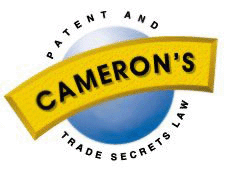
Pope Appliance Corp. v.
Spanish River Pulp & Paper Mills Ltd.
citation(s): (1929) 46, R.P.C. 23, (Judicial Committee of the Privy Council) per Viscount Dunedin
 |
Pope Appliance Corp. v.
|
copyright 1997 Donald M. Cameron, Aird & Berlis
"None of these persons found any prior references leading any of them to the compound trifluralin. It is possible that if any of their researchers had found anything of value in the prior art, faced as they were with the same problem as Eli Lilly (Soper), such prior art would have led them to make trifluralin; but all references in the prior art did not. Such prior art, therefore, could not have been "very plain"; or as Lord Wilberforce said in Mills & Rockley (Electronics) Ltd. v. Technograph Printed Circuits Ltd., supra, at p. 197:
One other point is worth making at this stage. Among those concerned with the general problem of replacing point to point wiring by something simpler, were some of the most powerful concerns in industry: Igranic, Philips, Radio Corporation of America, Bell Telephone Co., are names that speak for themselves. Yet by 1943 no generally workable method had evolved. The respondents' methods itself took, it is true, some time to establish itself as a commercial success... Its viability has been plainly vindicated.
Considering generally all the references cited in defence and after considering the evidence in chief and especially the cross-examinations, the evidence of Safe and the discovery evidence it is probable that at the time of the invention most of the references relied on in defence would probably not have been located by any researcher confronted with the problem which was solved by the making of the compound trifluralin. These references as stated are carefully selected pieces of prior knowledge, some not even concerned with herbicides; all probably not part of common knowledge. Also, it would be improbable that any such researcher would go outside the herbicide art and make a selection of references such as the defence made in this case of the prior art. It is impossible to assume in this case that such would have been made in any event.
What Soper did in this case is also to be distinguished from what was done in certain pharmaceutical cases where the alleged patent was found invalid because of obviousness. In those cases, the prior art disclosed the starting material. An example of these cases in Halocarbon (Ontario) Ltd. v. Farbwerke Hoechst AG., Vormals Meister Lucius & Bruning (1976), 28 C.P.R. (2d) 63, 13 N.R. 330, [1976] 2 F.C. 468, in which the prior art disclosed the starting material. Jackett, C.J., said at pp. 64-5 (includes footnote):
The only question in issue is whether the "liquid phase" aspect of this process involved "inventive ingenuity". It is also common ground that, in 1954, R.N. Haszeldine and B.R. Steele disclosed that the same "monomer" could be reacted with the same bromide under the same conditions to produce the same product. It appears that such a reaction might be carried out in what might be described as a "gaseous phase" or it might be carried out in what might be described as a "liquid phase"; but their paper did not specify that such reaction must be in any particular phase -"liquid" or "gaseous". (That being so, I am not inclined to disagree with the learned trial Judge when he holds that the Haszeldine disclosure does not constitute an anticipation of claim 10.) Prima facie, it seems to me that the Haszeldine disclosure is such a clear-cut indication of a "process" for making "isohalothane" by reacting the "monomer" with hydrogen bromide that there cannot be said to be any "inventive ingenuity" involved in discovering that the reaction can be brought about in the "liquid phase". (The respondent's argument, if I correctly appreciated it, was that, owing to the special nature of chemistry, where a chemical reaction is tried with useful results, inventive ingenuity is to be implied as long as that particular reaction had never actually been tried before. Even if that generalization is correct (a matter concerning which I have doubt), I have not been persuaded that the same thing can be said about trying an old reaction in a "phase" in which it had not previously been tried.) (There is no suggestion that once it was decided to try the reaction in "the liquid phase", there were difficulties encountered in accomplishing the reaction in the "liquid phase" that could only be overcome by "inventive ingenuity".)
Such is not the situation in this case. Again, in this case, the prior art at the time of the invention did not disclose the starting material which it was necessary to use to make trifluralin. Soper had to make a choice out of a selection of thousands of possible starting materials. He chose (and it would not have been obvious to a person skilled in the art to choose) the starting material that Yagupol'skii taught how to make. Soper chose that starting material because he had decided to make the compound later called trifluralin, which compound he later found to have the herbicidal functions desired.
"Would a man who was grappling with the problem solved by the patent attacked, and having no knowledge of that patent, if he had had the alleged anticipation in his hand, have said, "That gives me what I wish?"
Return to:
Cameron's IT Law: Home Page; Index
Cameron's Canadian Patent & Trade Secrets Law: Home Page; Index